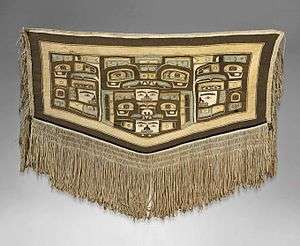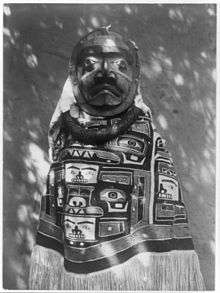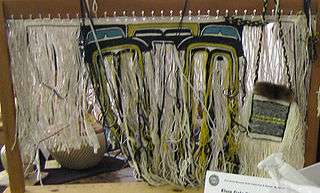Chilkat weaving
Chilkat weaving is a traditional form of weaving practiced by Tlingit, Haida, Tsimshian, and other Northwest Coast peoples of Alaska and British Columbia. Chilkat blankets are worn by high-ranking tribal members on civic or ceremonial occasions, including dances.

Background


The name derives from the Chilkat tribe[2] in Klukwan, Alaska on the Chilkat River. The Nisga'a are reputed to have invented the technique, according to some Tlingit weavers, though this is not attested in Tsimshian sources. Chilkat weaving can be applied to blankets, robes, dance tunics, aprons, leggings,[2] shirts, vests, bags, hats, and wall-hangings.[3] Chilkat clothing features long wool fringe that sways when the wearer dances.[2] Traditionally chiefs would wear Chilkat blankets during potlatch ceremonies.[4]
Chilkat weaving is one of the most complex weaving techniques in the world. It is unique in that the artist can create curvilinear and circular forms within the weave itself. A Chilkat blanket can take a year to weave. Traditionally mountain goat wool, dog fur, and yellow cedar bark are used in Chilkat weaving.[5] Today sheep wool might be used. The designs used Northwest Coast formlines, a traditional aesthetic language made up of ovoid, U-form, and S-form elements[6] to create highly stylized, but representational, clan crests and figures from oral history—often animals and especially their facial features. Yellow and black are dominant colors in the weavings,[5] as is the natural buff color of the undyed wool. Blue can be a secondary color.[7] Looms used in Chilkat weaving only have a top frame and vertical supports, with no bottom frame, so the warp threads hang freely. The weaver works in vertical sections, as opposed to moving horizontally from end to end.[5] Consequently, many designs are broken into vertical columns. As with most Northwest Coast art, these columns are bilaterally symmetrical.
Revival

In the 1990s, only an estimated six people still practiced true Chilkat weaving, but today the technique is enjoying a revival. Jennie Thlunaut (1891–1986) was a celebrated Chilkat weaver, whose knowledge of formline design was so thorough, she was able to create her own designs following the traditional rules.[8] Anna Brown Ehlers is a Chilkat Tlingit who apprenticed with Jennie Thlunaut since 1982.[9][10]
These tribes also create ravenstail weavings and button blankets.
See also
- Clarissa Rizal
- Jennie Thlunaut
- Northwest Coast art
- Native American art
Notes
- "Couverture Chilkat Chilkat blanket" (in French). Christie's. Archived from the original on 10 December 2013.
L'aspect atypique de cette couverture (l'absence d'écorce de cèdre dans les fils de chaîne, les deux ranges de franges, les broderies excentriques et les chevrons) fait la signature de cette artiste.
- Shearar 2000, p. 28.
- Brown 1998, p. 124.
- Dubin 1999, p. 403.
- Shearar 2000, p. 29.
- Dubin 1999, p. 398.
- Brown 1998, pp. 126–127.
- Brown 1998, p. 125.
- Clarissa Hudson. Clarissa Hudson Studio. (retrieved 17 March 2009) Archived February 28, 2009, at the Wayback Machine
- Anna Brown Ehlers: Chilkat Weaver. Archived 2008-11-02 at the Wayback Machine (retrieved 17 March 2009)
References
- Brown, Steven C. (1998). Native Visions: Evolution in Northwest Coast Art from the Eighteenth through the Twentieth Century. Seattle: University of Washington Press. ISBN 0-295-97658-6.CS1 maint: ref=harv (link)
- Dubin, Lois Sherr (1999). North American Indian Jewelry and Adornment: From Prehistory to the Present. New York: Harry N. Abrams. ISBN 0-8109-3689-5.CS1 maint: ref=harv (link)
- Shearar, Cheryl (2000). Understanding Northwest Coast Art. Vancouver: Douglas & McIntyre. ISBN 0-295-97973-9.CS1 maint: ref=harv (link)
External links
| Wikimedia Commons has media related to Chilkat weaving. |
- Ehlers, Ann Brown. "Chilkat weaver keeps vibrant tradition alive in Southeast". Archived from the original on 12 December 2013. Retrieved 12 December 2013.
- Ann Dornfeld (29 August 2017). "Does your Native American artwork belong to you — or to its tribe?". KUOW-FM.
